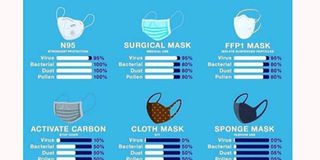Prime
Different types of masks and their effectiveness

Face masks have become one of the most important tools in the fight against the Covid-19 pandemic, with health officials advising the public to wear them.
Figuring out what to wear is not so easy. Health experts have advised that N95 and medical masks, which offer the most protection, should be reserved for health workers.
“In areas where there no cases of the virus, masks should be left for health workers. After all, they are in short supply. If the general population is taking them, they would be taking what the health workers would use when in proximity to people who are suspected to have the virus,” Dr Julius Lutwama, the deputy director of Uganda Virus Research Institute, said yesterday.
The mask should properly cover the mouth and nose. Below are some of the types of masks, how they work, and the level of protection they could provide.
N95
The N95 is the most recognisable and effective mask. These masks, which are designed for single use only, are made with polyester and other synthetic fibres that act as a filter to make it harder for particles to pass through. They can block at least 95 per cent of tiny particles estimated at 0.3 microns.
Some N95 masks have exhalation valves on the front, which make it easier to breathe. However, experts say they are not suitable for children and people with facial hair because they do not fit properly.
Surgical mask
This is a loose-fitting, disposable mask that creates a physical barrier between the mouth and nose of the wearer against potential contaminants in the immediate environment.
These medical masks come in a few varieties and are not as effective as the N95 masks
Medical masks are often made out of layers of breathable, paper like synthetic fabric that is cut into a rectangular shape and has pleats to help it expand and fit more snugly around your face. They are disposable and designed to be used just once.
A respirator
Respirators are divided into two categories, insulating and filtering. Filtering respirators consist of a face piece and a filtering device. Sometimes the filter element is integrated into the face piece. The mask is effective only against particles, gases and vapours.
Cloth mask and homemade masks
With increase in demand for masks, many people are making homemade masks which are mostly out of cotton.
A good homemade mask uses a material that is dense enough to capture viral particles, but breathable enough that you can tolerate it.
Health experts advise that one should look for cloth masks that have at least two layers of material that cover the nose and below the chin.
People have been experimenting with filtering materials, including air filters and vacuum bags.
They can be effective but can present risks. Many are not breathable and may contain harmful fibres that you could inhale.
Dr Lutwama says cloth masks are ideally not the best because clothes get wet very easily, which exposes one to the risk of infection.
“When they get wet, anything that falls on the other side of the mask will easily filter through and get into the mouth of the person putting it on,” he says.



